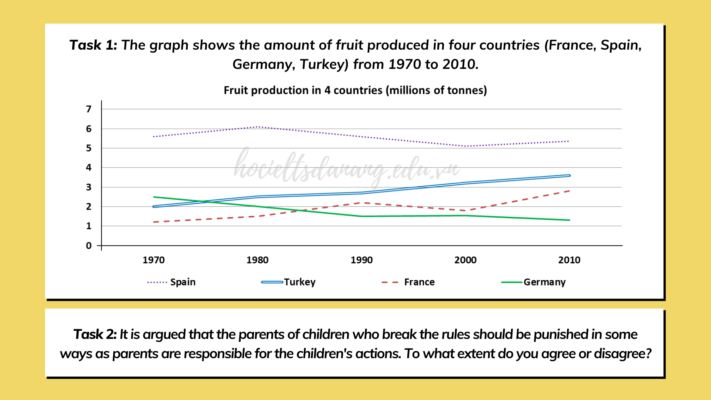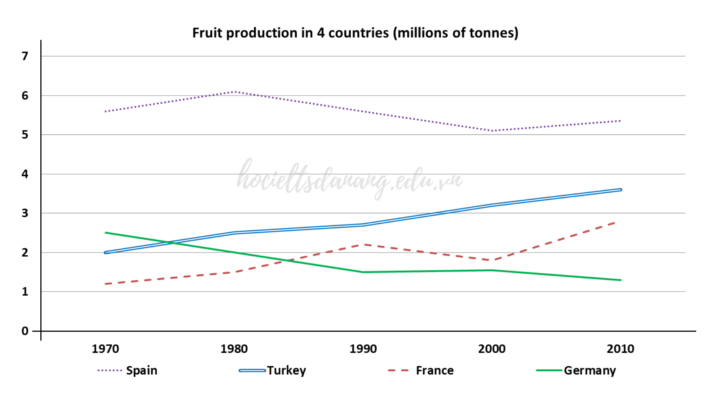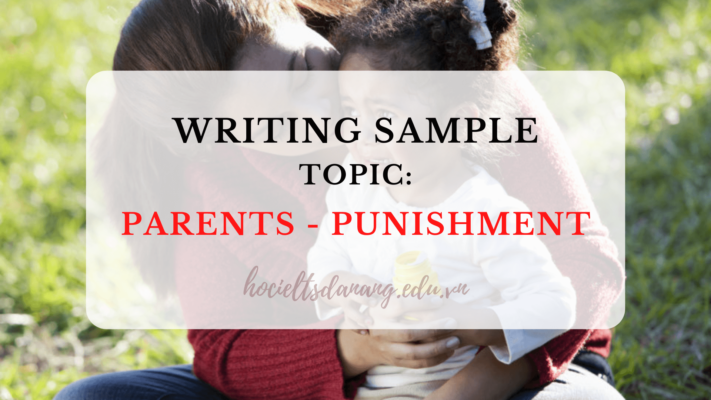Đề bài và Hướng dẫn giải đề IELTS Writing ngày 21/04/2022 chi tiết. Nhằm giúp các bạn đạt kết quả cao hơn trong kì thi IELTS sắp tới, Học IELTS đã tổng hợp lại các đề thi IELTS WRITING mới nhất 2022 tại Hội đồng Anh và IDP kèm theo bài mẫu chất lượng. Các bạn tham khảo bài viết bên dưới và ôn luyện IELTS thật tốt cùng Học IELTS nhé!

Mục lục bài viết
Giải đề IELTS Writing ngày 21/04/2022 – Task 1
The graph shows the amount of fruit produced in four countries (France, Spain, Germany, Turkey) from 1970 to 2010.

1. Dàn bài mẫu task 1 cho đề IELTS Writing ngày 21/04/2022
Với những bạn đã và đang luyện thi IELTS thì dạng bài Line graph trong đề IELTS Writing ngày 21/04/2022 – Task 1 rất quen thuộc. Chúng ta cùng phân tích qua đề bài và lên ý tưởng cho dàn bài nhé!
– Introduction:
Giới thiệu về sơ đồ (process) và nội dung chính của sơ đồ, paraphrase lại đề bài.
- … line graph demonstrates fruit production in 4 countries: … between … and …
Paraphrase:
- graph → line graph
- show → demonstrate
- the amount of fruit produced = fruit production
- from … to … → between … and …
– Overview:
-
The amount … in Turkey underwent a gradual increase – the opposite was true for Germany
(Số liệu của Turkey có xu hướng tăng đều trong giai đoạn, trong khi đó số liệu của Germany có xu hướng giảm dần.) -
The figure for Spain was always highest
(Số liệu của Spain luôn giữ vị trí cao nhất.)
– Body 1: Mô tả số liệu của Spain và Germany
-
Spain supplied the most fruit in 1970. Germany supplied only 2,5 million tonnes.
(Spain có sản lượng cao nhất trong giai đoạn 1970. Trong khi đó Germany chỉ đạt mức 2,5 triệu tấn.) -
1980: Spain rose to 6 million tonnes – the highest number.
Then gradually decreased and hit its bottom at 5 million tonnes.
(Vào năm 1980, Spain đạt 6 triệu tấn – mức cao nhất. Sau đó giảm dần và chạm đáy ở mức 5 triệu tấn.) - 1990: Germany hit the lowest point at 1,5 million tonnes.
Then remained stable for 10 years → slightly dropping for 0,25 million tonnes.
(Năm 1990, Germany đạt mức thấp nhất tại 1,5 triệu tấn. Số liệu duy trì đến năm 2000 sau đó giảm nhẹ khoảng 0,25 triệu tấn.)
– Body 2: Mô tả số liệu của Turkey và France
- 1970: the amount … in France was the lowest number.
(Năm 1970, số liệu của France đạt mức thấp nhất trong giai đoạn.) -
France: reduced in 2000 → significantly jumping at the end of the period.
(Số liệu của France giảm vào năm 2000, trước khi tăng mạnh và đạt mức cao nhất vào năm 2010.) - Turkey: gradually increased → reached 3,5 million tonnes in 2010.
(Turkey tăng đều và đạt khoảng 3,5 triệu tấn vào cuối giai đoạn.)
Gợi ý một số cấu trúc hay để miêu tả số liệu:
-
In 1980, fruit production in Spain rose to 6 million tonnes, which was the highest number during the period.
-
In 1990, fruit production in Germany hit the lowest point at 1,5 million tonnes, then remained stable for 10 years before slightly dropping for 0,25 million tonnes in 2010.
-
During the period, fruit manufacture in Turkey gradually increased and reached 3,5 million tonnes in 2010.
2. Bài viết mẫu task 1 cho đề IELTS Writing ngày 21/04/2022
The given line graph demonstrates fruit production in 4 countries: France, Spain, Germany and Turkey between 1970 and 2010.
Overall, it can be seen that the amount of fruit produced in Turkey underwent a gradual increase during the period, while the opposite was true for Germany. In addition, the figure for Spain was always highest from 1970 to 2010.
Spain supplied the most fruit (5,5 million tonnes) in 1970, whereas only 2,5 million tonnes of fruit were made in Germany. In 1980, fruit production in Spain rose to 6 million tonnes, which was the highest number during the period. This figure then gradually decreased and hit its bottom at 5 million tonnes. In 1990, fruit production in Germany hit the lowest point at 1,5 million tonnes, then remained stable for 10 years before slightly dropping for 0,25 million tonnes in 2010.
In 1970, the amount of fruit made in France was the lowest number during the period. Fruit production in France reduced in 2000 before significantly jumping to nearly 3 million tonnes at the end of the period. During the period, fruit manufacture in Turkey gradually increased and reached 3,5 million tonnes in 2010.
(By ZIM Academy)
Bản dịch:
(Biểu đồ đường thẳng cho thấy sản lượng trái cây ở 4 quốc gia: Pháp, Tây Ban Nha, Đức và Thổ Nhĩ Kỳ từ năm 1970 đến năm 2010.
Nhìn chung, có thể thấy rằng lượng trái cây sản xuất ở Thổ Nhĩ Kỳ trải qua giai đoạn tăng dần đều trong khi ở Đức thì ngược lại. Ngoài ra, con số này của Tây Ban Nha luôn cao nhất từ năm 1970 đến 2010.
Tây Ban Nha cung cấp nhiều trái cây nhất (5,5 triệu tấn) vào năm 1970, trong khi chỉ 2,5 triệu tấn trái cây được sản xuất tại Đức. Năm 1980, sản lượng trái cây ở Tây Ban Nha đã tăng lên 6 triệu tấn, đây là con số cao nhất trong thời kỳ này. Con số này sau đó giảm dần và chạm đáy ở mức 5 triệu tấn. Năm 1990, sản lượng trái cây ở Đức đạt mức thấp nhất là 1,5 triệu tấn, sau đó duy trì ổn định trong 10 năm trước khi giảm nhẹ xuống 0,25 triệu tấn vào năm 2010.
Năm 1970, số lượng trái cây sản xuất tại Pháp là con số thấp nhất trong thời kỳ này. Sản lượng trái cây ở Pháp giảm vào năm 2000 trước khi tăng đáng kể lên gần 3 triệu tấn vào cuối thời kỳ đó. Trong thời gian này, sản lượng trái cây ở Thổ Nhĩ Kỳ tăng dần và đạt 3,5 triệu tấn vào năm 2010.)
Giải đề IELTS Writing ngày 21/04/2022 – Task 2
It is argued that the parents of children who break the rules should be punished in some ways as parents are responsible for the children’s actions.
To what extent do you agree or disagree?

Các đề bài liên quan với task 2 của đề IELTS Writing ngày 21/04/2022
-
The best way to reduce youth crimes is to educate their parents with parental skills. To what extent do you agree or disagree?
-
In some countries, a high proportion of criminal acts are committed by teenagers. Why has this happened? What can be done to deal with this?
1. Phân tích đề IELTS Writing ngày 21/04/2022
– Phạm vi chủ đề: khi con cái vi phạm quy tắc thì cha mẹ cũng nên bị phạt
– Nhiệm vụ:
-
Bày tỏ quan điểm đối với vấn đề trên
– Định nghĩa các khái niệm có trong đề:
-
Children who break the law: trẻ em phạm pháp
-
Parents are responsible for their children’s action: cha mẹ chịu trách nhiệm cho hành động của con cái
-
Parents should be punished: cha mẹ nên bị phạt
2. Dàn bài mẫu cho đề IELTS Writing ngày 21/04/2022
INTRODUCTION
– Giới thiệu chủ đề và dẫn dắt vào vấn đề. Paraphrase đề bài (General statement).
- … parents should be responsible or even punished for crimes committed by their children.
(cha mẹ nên chịu trách nhiệm hoặc thậm chí bị trừng phạt cho những vi phạm mà con cái họ đã gây ra)
– Trả lời câu hỏi của đề bài (Thesis statement): Đưa ra quan điểm của người viết về ý kiến trên.
- While juvenile delinquency may be due to parents’ failure…, I believe that teenage lawbreakers should take all accountability…
(Mặc dù vị thành niên phạm pháp có thể là do cha mẹ …, nhưng tôi tin rằng những người vi phạm pháp luật ở tuổi vị thành niên nên chịu mọi trách nhiệm …)
BODY 1: Cha mẹ nên chịu trách nhiệm cho hành vi phạm lỗi của con họ
– Sử dụng cấu trúc: “More often than not, …“
– Do gia đình bất hòa, không hạnh phúc → hành động sai phạm của con cái
- dysfunctional family with abusive parents/ divorced parents/ parents who put too much academic pressure on their children
(gia đình rối loạn chức năng với cha mẹ bạo hành, cha mẹ ly hôn hoặc cha mẹ đặt quá nhiều áp lực học tập lên con cái) - lack of care toward children’s emotions → more vulnerable to cognitive distortion
(thiếu quan tâm đến cảm xúc của trẻ → trẻ em trở nên dễ bị méo mó về mặt nhận thức) - children tend to think more negatively, feel worthless…
(xu hướng suy nghĩ tiêu cực hơn, cảm thấy mình vô giá trị…)
– Con cái chịu tổn thương tâm lý → dễ sa ngã, phạm tội
– Sử dụng cấu trúc: “Indeed, statistics agree that …“
- experienced emotional crises due to broken families → anti-social attitudes
(khủng hoảng tinh thần do gia đình tan vỡ → thái độ chống đối xã hội) - parents raise their kids without love
(cha mẹ không nuôi dạy con cái bằng tình yêu thương)
BODY 2: Người phạm lỗi cũng nên chịu trách nhiệm cho hành vi của mình
– Sử dụng cấu trúc: “Nevertheless, I insist that …“
– Hình phạt giúp cải tạo chính bản thân người đó
- ensure a justice system based on fairness and criminal deterrence
(đảm bảo một hệ thống tư pháp dựa trên sự công bằng và răn đe tội phạm) - Punishment is to let them understand the price for their actions
(Hình phạt là để họ hiểu cái giá phải trả cho hành động của mình)
– Hình phạt để răn đe những hành vi phạm tội khác
- deter the risk of other teenages’ committing anti-social behaviors
(ngăn chặn nguy cơ các thanh thiếu niên khác thực hiện các hành vi chống lại xã hội.) - make society a safer and more peaceful place.
(làm cho xã hội trở thành một nơi an toàn và yên bình hơn)
CONCLUSION
– Tóm lại ý chính của bài viết (Summarize the main ideas)
- In conclusion, although parents …, they should not take all responsibility. It is suggested to punish juvenile lawbreakers as a way to …
(Tóm lại, do … vẫn chọn sách và các nền tảng kỹ thuật số làm công cụ học tập.)
3. Bài viết mẫu task 2 cho đề IELTS Writing ngày 21/04/2022
INTRODUCTION
It is argued that parents should be responsible or even punished for crimes committed by their children. While juvenile delinquency may be due to parents’ failure in raising their children, I believe that teenage lawbreakers should take all accountability for their offenses.
BODY 1
More often than not, children’s anti-social behaviors could be traced back to a dysfunctional family with abusive parents, divorced parents or parents who put too much academic pressure on their children. These generally share one feature in common which is a lack of care toward children’s emotions. Due to this unhappy childhood, children become more vulnerable to cognitive distortion; they tend to think more negatively, feel worthless, and consider social offenses a way to prove their worth to the world.
Indeed, statistics agree that many juvenile offenders have experienced emotional crises due to their broken families, which leads to their anti-social attitudes. As several roots of evils committed by children are from parents’ failure to raise their kids with love, parents should be partly accountable for their children’s illegal behaviors.
BODY 2
Nevertheless, I insist that the lawbreakers themselves, not their parents, should be punished to ensure a justice system based on fairness and criminal deterrence. Firstly, it is unjust for offenders to escape legal punishment and continue their normal lives despite harming society. Punishment is to let them understand the price for their actions, and could vary, depending on the seriousness of the behavior. Secondly, the threat of being punished would deter the risk of other teenagers’ committing anti-social behaviors. This will make society a safer and more peaceful place.
CONCLUSION
In conclusion, although parents play a part in their children’s wrongdoings, they should not take major or all responsibility for that. It is suggested to punish juvenile lawbreakers as a way to ensure a just legal system and alleviate the risk of potential criminals.
(By ZIM Academy)

Sample 2:
INTRODUCTION
Juvenile delinquency has risen considerably than ever before. In many circles, it is argued that parents ought to be punished in some way. In contrast, others concede that it does not necessarily parents’ fault, although it is the onus on them to rear their children so that they become responsible citizen towards society. In this instance, I am of my honest opinion that nobody should be punished for the crime he has not committed at all.
BODY 1
Nevertheless, some children may engage in anti-social activities. And parents of these children always discourage such activities. They try to convince the child. They scold the child sometimes. Notwithstanding the love and scolding used in parenting, the child may become recalcitrant. So, this will be really unfair to punish the parents for their child’s offence.
BODY 2
Besides, there are other factors what may indulge a child to engage in anti-social activities. It is seen that children very often are influenced by the violent movies or TV programs and gangs around them. Characters of these movies are presented in pompous fashion and the exposure to violence that may easily entice the children involving in anti-social activities.
That is to say that the heavy exposure to violence through movies, TV programs, Internet sites, video games, and even cartoons has long been associated with a rise in the probability that a child will become susceptible to violence and behave in antisocial and aggressive ways.
Another key fact is that antisocial behavior may also developed by the child’s irritability and temperament. Several factors, thus, contribute to the development of children antisocial behavior which have no relation to parents.
CONCLUSION
To recapitulate, parents always try to ensure their children not to involve in activities deemed as antisocial in nature. Besides, there are other factors lie in the social context the children live in contribute to the shaping antisocial behavior. Above all, the state or society has no moral justification to punish anybody who does not commit crimes. That is why, I firmly believe that it will be injustice to the parents if they are punished for their children’s crime.
Bản dịch:
Tuy nhiên, một số trẻ em có thể tham gia vào các hoạt động chống đối xã hội. Và cha mẹ của những đứa trẻ này luôn không khuyến khích những hoạt động như vậy. Họ cố gắng thuyết phục đứa trẻ. Họ mắng đứa trẻ đôi khi. Bất kể tình yêu và sự la mắng được sử dụng trong quá trình nuôi dạy con cái, đứa trẻ có thể trở nên ngoan cố. Vì vậy, điều này sẽ thực sự không công bằng khi trừng phạt cha mẹ vì hành vi phạm tội của con họ.
Bên cạnh đó, có những yếu tố khác có thể khiến trẻ tham gia vào các hoạt động chống đối xã hội. Người ta thấy rằng trẻ em rất thường bị ảnh hưởng bởi phim bạo lực hoặc chương trình truyền hình. Nhân vật của những bộ phim này được thể hiện theo phong cách hào hoa và bạo lực có thể dễ dàng lôi kéo trẻ em tham gia vào các hoạt động chống đối xã hội.
Điều đó có nghĩa là việc tiếp xúc nhiều với bạo lực qua phim, chương trình truyền hình, Internet, game và phim hoạt hình có liên quan đến việc gia tăng bạo lực và cư xử theo những cách chống đối xã hội và hung hãn.
Một thực tế quan trọng khác là hành vi chống đối xã hội cũng có thể phát triển do tính cách cáu kỉnh và nóng nảy của trẻ. Do đó, một số yếu tố góp phần vào sự phát triển của trẻ em hành vi chống đối xã hội mà không liên quan đến cha mẹ.
4. Từ vựng
-
juvenile delinquency: tội phạm thanh thiếu niên
-
lawbreakers: kẻ phạm pháp
-
take all accountability for: chịu toàn bộ trách nhiệm cho
-
anti-social behaviors: các hành vi chống đối xã hội
-
dysfunctional family: gia đình bất hòa
-
cognitive distortion: lối suy nghĩ méo mó
-
justice system: hệ thống luật pháp
-
criminal deterrence: răn đe tội phạm
-
unjust (adj): bất công
-
alleviate the risk of potential crimes: giảm nguy cơ phạm tội
Trên đây là hướng dẫn giải chi tiết đề thi IELTS Writing ngày 21/04/2022. Các bạn tham khảo và áp dụng vào phần luyện tập để nâng cao kỹ năng Writing của mình nhé! Chúc các bạn học tập và ôn luyện thật tốt nhé!
Xem thêm: Tổng hợp đề IELTS Writing 2022 (có bài mẫu) – IELTS Writing actual test

